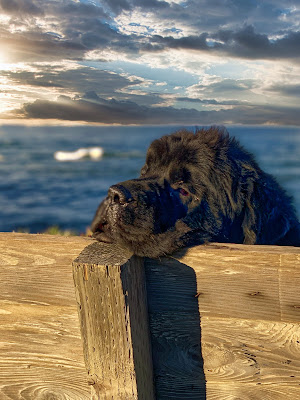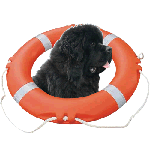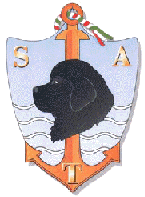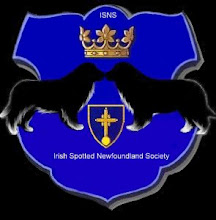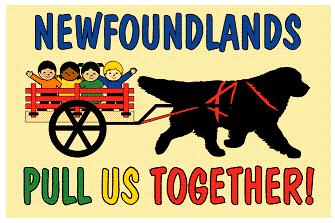Friday, December 31, 2021
Saturday, December 25, 2021
Saturday, December 11, 2021
Saturday, December 4, 2021
To Howl At The Moon
"Sister moon will be my guide,
In your blue blue shadows I would hide.
All good people asleep tonight,
I'm all by myself in your silver light.
I would gaze at your face the whole night through,
I'd go out of my mind, but for you.
Lying in a mother's arms,
The primal root of a woman's charms.
I'm a stranger to the sun,
My eyes are too weak,
How cold is a heart,
When it's warmth that he seeks?
You watch every night, you don't care what I do.
I'd go out of my mind, but for you,
I'd go out of my mind, but for you.
My mistress' eyes are nothing like the sun;
My hunger for her explains everything I've done.
To howl at the moon the whole night through,
And they really don't care if I do.
I'd go out of my mind, but for you."
(Sting - Sister Moon)
Thursday, November 25, 2021
Friday, November 12, 2021
An Officer, A Gentleman and a Newfoundland
(As told by Satchel & Andrew)
We wanted to bring you the story of our Grandpa and his first Newfie.
Grandpa served for several years in the U.S. Air Force in Italy and the Persian Gulf during World War II. He was a highly decorated Lieutenant and spent much of his time in dangerous reconnaissance work.
One of his last assignments came in leading a supply platoon into Russia during the winter of 1944. After successfully getting the supplies into the hands of Russian troops, Grandpa was approached by a young Russian soldier. The soldier had a Newfie puppy and he was being shipped out and could not take the Newfie with him. He pleaded with Grandpa to take the Newfie so that it would have a good home and not face a very uncertain future.
Grandpa agreed and the brief encounter between two soldiers was enough for handshakes, hugs, and best wishes to be exchanged.
Only a few weeks later, Grandpa received his orders to return home after years away from Grandma and his family. He had named the puppy "Franny" and was very concerned about how he would get Franny back home with him. After considerable thought, he decided to see if the pilot of the Air Force plane would take some money and store Franny underneath the pilot's seat. The pilot agreed, and Grandpa put Franny in a cardboard box with holes in it so she could breath. He gave her a sleeping pill so that no one else would know of the precious cargo.
Well, all went well, and Franny made her way with Grandpa back to Chicago and then on to San Francisco, where she lived until 1958 with two daughters who loved her dearly. Grandpa had brought back a Persian rug he kept in his office overseas. He put it in his basement office at home when he got back, and he and Franny spent many fond hours there curled up on the rug.
Not long after finally getting home, Grandpa wrote a poem to Franny, entitled,
"Lines To A Curled Up Franny":
"Little Franny, lax and lazy
With a mind extremely hazy
In regard to human cares
Far removed from worldly affairs.
"There you lie your tail around you
With no Charlotte to hound you
With no taxes to be met
With no spending to regret.
"There you snuggle on the Persian
Bothered not by reconversion
Void of grief and sacrifice
Dreaming dreams of cats and mice."
(Lt. Samuel D. Sayad)
(March 30 1913 - July 29 1986)
Tuesday, November 9, 2021
Poole And The Newfoundland Dog
(The Poole Museum Society)
"There is a story that when Napoleon Bonaparte was escaping from Elba, he fell into the sea. In the darkness, the sailors could not find him but a Newfoundland dog that was in the boat jumped into the water and rescued the drowning emperor. Had the dog not possessed such skill and tenacity, the battle of Waterloo might never have happened.
This remarkable breed probably originated from the ‘St. John’s’ dogs used by the native inhabitants of Newfoundland. By the time John Cabot landed on the coast of the island in the late 14th century, the Newfoundland dog had developed into huge animal with a black double coat, webbed feet and a massive head. Following Cabot’s voyage, European ships began to visit the island for the seasonal fishing and some of them carried dogs on board which bred with the native species. As Poole ships were involved in the fishing trade from the early 15th century, it is possible that Dorset dogs were among those transported across the Atlantic.
Different varieties gradually appeared, including brown, grey and black and white dogs. One black and white animal was later immortalised by Sir Edwin Landseer in his 1838 painting 'A Distinguished Member of Humane Society.' His subject was credited with having saved 20 people from drowning and was therefore adopted as a member of the Society. This variety soon acquired the name ‘Landseers.'
Life-saving was just one of the characteristics of the breed. Newfoundland dogs were intelligent, calm and loyal as well as being excellent water dogs and strong swimmers with a powerful instinct to retrieve objects and people. This made them invaluable to fishermen who would use them to haul in nets or retrieve fish. When fishermen were using a jigger (a weight with two unbaited hooks which was jiggled in the water), the fish would sometimes slip off the hook. The dogs were skilled at retrieving fish with their paws or jumping into the water to bring the fish ashore and pile it up as they had seen men do. They were also employed to pull sleds loaded with fish, nets, firewood, milk, mail and other goods across rough ground inaccessible to a pony. Trained dogs could even transport goods on their own without the owner having to go with them. It was said that a good dog could earn his owner’s keep during the winter months.
Not surprisingly, European captains began to bring Newfoundland dogs back with them across the Atlantic as a valuable side-line, demonstrating their skills at ports where they landed. The dogs were soon in demand for their novelty or as working and sporting animals. Portraits from the early 18th century onwards show the presence of Newfoundland dogs in wealthy households while sportsmen valued them for their ability to retrieve wildfowl from the sea.
In the late 18th century, Poole was became one of the leading ports for the Newfoundland trade and a major supply centre for dogs. Col. Peter Hawker in his ‘Instructions to Young Sportsmen’, first published in 1814, wrote that ‘Poole was of late years, the best place to buy Newfoundland dogs; either just imported or broken in, but now they are become much more scarce, owing (the sailors observe) to the strictures of those — tax-gathers.’ However, fifty years later the Rev. Thomas Pearce was still writing in ‘The Field’ about buying ‘several excellent dogs out of the Mountaineer of Poole, on her arrival from White Bay, St. John’s’ and mentioned ‘Snow', a dog I bought at the King’s Arms in Poole directly he landed in the autumn of 1859’. He also asserted that ‘those captains who pay any attention to dogs know very well where to procure good specimens and we who live near Poole know the right men to deal with.' Some dogs were brought in on commission and others sold at auctions or transported to London and elsewhere to be sold.
Newfoundland dogs were also used to pull carts as an alternative to horses or ponies. In the early 1800s, the dog-cart was ‘one of the usual sights of Poole . . . One two or three dogs were harnessed to a shallow cart of about two feet wide and a yard long, and these dogs were used for local haulage and domestic work around the narrow streets of Poole, as well as for fast relays in the delivery of fresh fish along the South Coast and even to London.’ Dog carts were a familiar sight in many towns but a rabies scare in London in the 1830s together with humanitarian considerations, caused them to be banned in the city in 1839. The following year, Poole’s first Liberal Council revised the byelaws to ban the use of dog-carts in Poole. However as late as 1853, James Bugden was prosecuted and fined in Poole Guildhall for using dogs for haulage. An Act of Parliament outlawed the practice throughout the country in 1855.
Newfoundland dogs were still being bred in the area and a large pack was owned by Mr Henry Richard Farquarson of Eastbury House, Tarrant Gunville, M.P. for South Dorset. He used to send carts down to Poole to collect dogs from the Newfoundland timber ships. Two kennel lads had the job of exercising the dogs and bitches in separate groups. One day around 1890, due to a misunderstanding, the two groups met up on Chettle Down. The usually placid dogs were not proof against the instinct to compete for the females and a big fight ensued. As a result, 45 dogs were killed or had to be put down.
The incident is a rare example of aggression from this amiable, hard-working breed. Today, Newfoundland dogs are still bred and kept in the vicinity of Poole but their days of arriving on sailing ships from the other side of the Atlantic or drawing carts through the streets of the old town, are long gone."
Saturday, November 6, 2021
Henry - One Year
Henry arrived one year ago today.
He is, like all Newfies, a wonder of infinite joy and love.
Mississippi-Missouri Largos
Sunday, October 31, 2021
Friday, October 22, 2021
The Ghostly Sighting Of An Ever-Faithful Newfoundland Dog
The ghost of a black Newfoundland dog has been seen many times at the
St. Patrick's Cathedral in Dublin, Ireland, sitting at the base of a memorial statue to Captain John McNeill
Boyd who was lost in February, 1861 while attempting to rescue drowning
seamen at Dun Laoghaire. The apparition is said to be that of Captain
Boyd's devoted dog which has also been seen many times lying on his
master's grave at nearby Glasnevin Cemetery.
On the night of Saturday 8th February, 1861, the Irish Sea was swept by
one of the worst gales of the century. The harbour at Kingstown, now Dun
Laoghaire, was littered with debris and the wreckage of battered
vessels. Scores of bodies of drowned people were found on the
shoreline. Among those who helped to recover the bodies and clear the
wreckage was Captain Boyd, in command of the coastguard vessel Ajax.
Three stricken vessels, the Neptune, the Industry and the Mary, were
trying to get to the shelter of the harbour. The Neptune and the
Industry were to be smashed against the rocks whilst the Mary was
wrecked further along the coast at Sandymount. Captain Boyd and some of
his men were on the rocks trying to rescue the men from the stricken
vessels. Together with three of his men he was swept into the sea by a
giant wave. When a lifeboat from the Ajax later went to search for
Captain Boyd and the three other men, his faithful Newfoundland dog was
in the rescue boat.
When the body of Captain Boyd was finally recovered it was brought
ashore and he was given one of the biggest funerals ever seen in Dublin.
During the funeral procession his faithful dog walked beside the coffin
and followed it to Glasnevin Cemetery where Captain Boyd was interred.
When the grave was filled in, the dog, so devoted to his master, lay on
top and refused to be moved, eventually dying of hunger. Shortly
afterwards the memorial statue to Captain Boyd was erected in the
Cathedral by the people of Dublin.
Wednesday, October 20, 2021
Monday, October 11, 2021
The Dog From Newfoundland
(lewisclark.org)
"The breed of these handsome and powerful dogs, now (in 1840) common in Great Britain, wrote Col. Smith, especially the hound, 'and therefore differs somewhat from the original indigenous race of [North] America.' Newfoundlands of the 1840s in England were larger than those of the original stock in the American colonies, and were generally white with black spots. The original Newfoundland was smaller, the body more slender, forehead more arched, the muzzle sharper, and 'nearly all of a totally black colour, excepting a bright rust coloured spot above each eye, some fulvous [reddish-yellow, tawny] towards the nose, throat, and upon the joints; there was also a little white about the feet, and in the end of the tail.
But those superficial details aside, the breed bore some unique attributes that clearly fitted it for a large, mostly water-borne expedition that expected to meet new strangers frequently. The 'true breed of this race, Smith continued, 'is almost semi-palmated; and, consequently, they swim, dive, and endure the water, better and longer than any other dog in existence.' Joining the chorus of praise and admiration for the breed, he emphasized, 'no dog is better qualified to serve in harness, or fitter to watch and guard property on shore, or vessels in the coasting trade, rivers, or canals. As a waterdog, he can be taught to execute almost any command; and his kind disposition makes training easy, when used in the field.
Smith also invoked the history of these dogs not as pets but seasonal helpmates to generations of fishermen in Nova Scotia and Newfoundland from sometime in the 1400s until the end of the 20th century. Before the 1840s, he wrote, there may have been as many as 2,000 of them around the seaport of St. John's, Newfoundland. Throughout the entire annual cod-fishing season, for nearly 300 years, they were left to shift for themselves while their masters were out on the Grand Banks. Traditionally regarded as descendants of wild dogs and wolves, they were allowed to remain starving, diseased, and even dangerous to the human population. When the fishermen returned, the surviving dogs took up their work again, pulling carts or sleds loaded with firewood, fish for the table, and other bulk supplies until the next cod season began.
Aware of the steadily growing fear of epizoötics of rabies in heavily populated areas in America as well as Europe, Col. Smith added the note that that dreaded disease did not afflict the untended Newfies, but only that a kind of plague, originating in the neglect and misery they suffered, occasionally destroyed great numbers of them.
EARLY 1800's BREED:
The Newfoundland dog, wrote the British naturalist William Taplin (1740?-1807) in 1803, was 'not known amongst us, till imported from that country whose name it continues to bear.' The Newfoundland 'in a state of purity, uncontaminated by the blood of any inferior race," he declared, "is one of the most majestic and awefully [impressively] attracting of all the canine variety.'
Taplin continued with a paean to the breed:
'Docile beyond conception, and affectionate beyond description, the Newfoundland dog is easily taught almost every thing within the power of the human mind to inculcate, of which his own strength and frame are capable. Equally sagacious as energetic, he patiently perseveres in whatever he undertakes, and never relinquishes the attempt so long as there remains the most distant hope, or possibility of success . . . . The sagacity of this animal is so palpably blended with a peculiarly attentive attachment to the human species, and such an instantaneous sense of impending danger, that the inactive mind, lulled to an apathy, becomes immediately roused to action in the contemplation.'
Philip Reinagle (1749-1815), the artist who created this portrait, was known primarily for his landscapes and depictions of familiar animals, especially sporting scenes containing dogs and birds. He created all the drawings for the engravings in Taplin's descriptive catalog of sporting dogs. He places an oversized dog against a background of exaggerated mountain crags, with the added dramatic detail of a working dog team that is just large enough to convey a message, even though it foreshortens the perspective.
WORKING DOG:
The Newfoundland dog, wrote Taplin, 'is habitually used in its native country, for the purposes of draught. They are easily broken in, and soon inured to the trammels of harness; three, four, or five are used in a sledge or other vehicle, and will convey a load of some hundreds weight for many miles with great ease.'
LAND OF THE NEWFIE:
Geographically, the most easterly part of North America is the island called Newfoundland. Named Terre-Neuve— literally 'land-new,' or 'New-(found)-land'—by 15th century explorers. Northwest of Newfoundland, across the Strait of Belle Isle, is Labrador, the larger mainland, peninsular part of the old entities which, in 2001 were politically merged into the province of Newfoundland-Labrador.
West of Newfoundland-Labrador is the Gulf of St. Lawrence; to the southwest beyond Cabot Strait are Cape Breton Island and peninsular Nova Scotia ('New Scotland'). East and south of Newfoundland-Labrador are the plankton-rich waters of the historic, world famous fishing ground known as the Grand Banks—where the Newfoundland dog honed its water skills in behalf of fishermen from the nearby provinces and New England. Since 1990, a wide variety of technological "advances" have led to over-fishing and a corresponding decline of commercially viable fish populations.
A key observation here: "there was also a little white about the feet, and in the end of the tail."
Friday, October 1, 2021
Wednesday, September 29, 2021
When We Two Parted
"If I should meet thee -
After long years -
How should I greet thee? –
With silence and tears."
(Lord Byron)
Saturday, September 18, 2021
The Newfie Beer
(ST. JOHN'S, N.L.)
"India Beer has been a staple of the downtown St. John's bar scene for a long time. Brewed and distributed exclusively in Newfoundland and Labrador, its iconic logo features a Newfoundland dog above the tagline 'Man's Best Friend.'
Jason Hull, area sales manager for Molson in Atlantic Canada, reckons India has plenty of friends in St. John's, estimating 80 per cent of the lager’s sales are in Newfoundland and Labrador's capital city.
'We never really pushed it as a company,' said Hull, who has worked with Molson since 1999 and can recall how it was embraced back then as a brand by the local arts community and other folks in the downtown scene.
'We never hid that it was a Molson product or anything, but people just really love the history behind it — the fact that it's made here in Newfoundland and Labrador, and it just resonates with that group.'
First brewed by the Newfoundland Brewing Co. in the late 1800s, India Beer found a new home with Molson in the 1960s when it acquired the independent brewery.
For a long time, Molson and Labatt products were just about the only options in town when it came to beer, but the blossoming craft brewing industry has changed the landscape dramatically. Local beer drinkers like to try all kinds of style, with India pale ales (IPAs) proving to be especially popular nowadays.
'Certainly, there's been an explosion of craft products across North America and in Newfoundland and Labrador," Hull said. "We see that (IPA) is the Number One style out there.'
With that in mind, Molson is lending the India name and logo to a new beer brewed exclusively out of its Circular Road brewery in St. John's. The India Beer IPA, a session IPA with five per cent alcohol by volume, was released in stores this past week.
'It was really just to give our India drinkers a little different flavour out there,' Hull explained. 'We have lots (of IPAs) in our portfolio. We can get beers from B.C., get beers from anywhere we want and get an IPA. But there was something about having it made on Circular Road and putting the India name on it that made it kind of special for us and the people at the brewery.'
The Newfoundland Brewing Co. did have its own IPA decades ago, but it's not serving as a direct inspiration for the new brew’s recipe. Hull said the India Beer IPA has a hazy look and tropical notes in its taste, making use of Citra, Mosaic and El Dorado hops.
'It’s very sessionable,' Hull said. 'It’s for someone that wants to sip on a couple of them. It’s pretty easy drinking.'
The idea for producing an India-branded IPA came about a year ago.
'We just thought we have a lot of drinkers out there that like India, that like other Molson products, and we just wanted to open up the offering to them really and show them what we have ... We're known obviously for our mainstream beers ... we can put out a really good IPA as well if they're looking for one from us.'
India Beer IPA is available in 473-mililitre pint cans and as an eight-pack of 355-millilitre cans. It's also available on tap at select locations."
Saturday, September 11, 2021
The Canine Heroes Of September 11
(www.AKC.org)
"On first glance, this picture, from 2012, is one of unbearable sweetness. Two Golden Retrievers are standing together, one with a gray muzzle, the other a puppy, both wearing vests signifying that they are working dogs.
The older dog is Bretagne, one of the heroes of Ground Zero. Nearly 15 years after the event, she was still making headlines. In August 2015, media carried the story of a happy occasion—her 16th birthday, in which she and her handler Denise Corliss, members of Texas Task Force 1, were feted in New York City. In June 2016, sadder headlines told of her death, just shy of the great old age of 17.
The puppy in the picture is also Bretagne, named in honor of the 9/11 sniffing celebrity. She is one small part of the legacy of Bretagne and all the other dogs who helped through those dark days, whether they were searching the ruins or easing unimaginable grief.
Young Bretagne, trained to detect blood sugar fluctuations in a diabetic patient, is a graduate of a training school—the Penn Vet Working Dog Center. This training school is the brainchild of Dr. Cynthia M. Otto, a veterinarian who worked at Ground Zero.
Otto says that the work of the dogs in that terrible time made her facility possible.
Sniffer dogs had been around for decades, but the public had little understanding of what they could do. 'There was some sense that they might be able to find a lost Boy Scout in the woods but nothing of the scope and impact of a national disaster [even though they had a critical role in the Oklahoma City bombing and several natural disasters],' says Otto.
Media coverage of 9/11 focused on the dogs as the one 'ray of sunshine' in a bleak landscape, she says.
Images of these dogs working tirelessly, doing whatever was needed to get the job done, captured hearts and minds all over the world. Photos, such as the iconic one of Golden Retriever Riley of FEMA’s Pennsylvania Task Force 1, moved people to action.
Otto says that many dog owners were inspired to pursue search-and-rescue certification because of those images.
The performance of the dogs on 9/11 also sparked serious study of the effects of this kind of work on canine bodies and minds, Otto says. “We were able to conduct our longitudinal study of the dogs as a result of the generous funding of the AKC Canine Health Foundation.”
Press coverage, she says, also gave some search-dog training organizations a much-needed financial boost.
Super Noses?:
One of those organizations is the nonprofit National Disaster Search Dog Foundation, a group founded in 1995 by a retired teacher, Wilma Melville.
After her first deployment—the Oklahoma City bombing, in 1995—Melville recognized a need for more dogs specifically trained for this kind of work and founded the NSDF. The organization scours shelters, looking for dogs with search and rescue potential, and prepares them for jobs with fire departments. The training costs about $10,000. NSDF provides the dogs free of charge.
'Most people in this country had never heard of disaster search dogs [before 9/11],' says NSDF Executive Director Debra Tosch. When the news media started focusing on the dogs at Ground Zero, she says, 'public knowledge really exploded.
Tosch, and her SDF-trained black Labrador Retriever, Abby, were among the FEMA-certified canine search specialists, part of California Task Force 1, at the World Trade Center.
About 300 search teams, she estimated, responded. Only about 100 were prepared for a disaster of monstrous proportions in a major city. Many were wilderness search and rescue dogs, experts at finding people missing in the woods. They could not cope with the enormous mound of twisted metal, glass, and smoldering rubble and the urban noises.
Tosch says that some television coverage listed NSDF’s phone number. Donations started to pour in. 'We had this influx of funding right after the World Trade Center,' Tosch says. The support and publicity helped make Melville’s 20-year dream—the National Training Center, slated to open on September 24—a reality. It’s designed to give canine candidates the opportunity to practice on a variety of simulated disaster sites.
Soothing Souls:
The notion that dogs have the power to ease human emotional suffering is not new. Anyone who’s cried in the presence of a canine companion knows that. Smoky, a 4-pound Yorkshire Terrier, is credited with being the first therapy dog, cheering wounded soldiers in hospitals on the islands around New Guinea during World War II.
Dog trainer Cindy Ehlers first recognized the power of therapy dogs after the May 21, 1998, Thurston High School shooting, in Springfield, Oregon. She accompanied one of the first therapy dogs to work with the Red Cross in a disaster and one of the first to be certified for crisis-response.
After that experience, Ehlers got a Keeshond puppy she named Tikva, and trained her for crisis-response work. She also started an organization that is today the HOPE Animal-Assisted Crisis Response, in Eugene, Oregon.
On 9/11, Ehlers and Tikva traveled to New York. Dealing with such enormous waves of grief, fear, and confusion goes way beyond what is required of a therapy dog who visits hospitals and nursing homes. Ehlers says she saw some become too stressed to work.
Most teams stayed at the Family Assistance Centers, helping the relatives of the dead and missing. Red Cross mental-health experts saw that workers were not talking to the human therapists, and thought maybe they would talk to the dogs. Tikva, because of her crisis-relief training, became one of the few dogs who worked at Ground Zero helping the responders. Her preparation for working in this environment, as well as her cute looks, rock-solid temperament, and unusual breed, made her ideal for taking minds off the horror, if just for a few moments.
Ehlers says that that was where these four-legged therapists earned the sobriquet that they are known by now. 'A firefighter called up V-Mat [Veterinary Medical Assistance Teams] after we left and said, ‘Where are those comfort dogs? They’re the only thing that helps me get through the day.’
Growing Need For Therapy Dogs:
A new era for therapy dogs opened on 9/11, says Ursula Kempe, president of Therapy Dogs International, which she co-founded in the mid-1970s. TDI sent 100 teams to New York, where they worked at the Family Assistance Center on Pier 94 and 50 at the Pentagon. They spent about four weeks there. Kempe says that most of the dogs rose to the challenge, but some could not handle it.
'While this was still going on, I called a meeting at TDI and asked everyone who was involved if they wanted to come. We all realized—really there was absolutely no dissention—we are not prepared for that, as therapy-dog handlers.'
TDI tightened its criteria, requiring additional preparation for the human handlers and special certification for dogs participating in disaster relief. Since then, TDI teams have helped people cope with all kinds of disasters, from Hurricane Katrina to mass shootings to acts of terrorism.
Kempe says the way the world views working dogs has come a long way, but improvements are still needed. For example, only service dogs can travel by plane in the cabin with their owners. Kempe is trying to persuade airlines to allow disaster-relief comfort dogs to do the same. This one change, she says, would bring many more dogs to places where they are needed. Handlers are reluctant to transport their canine partners in baggage.
The Future of Working Dogs:
Otto believes that the need for dogs trained for all kinds of serious work is going to soar in the future, and more funding, facilities, and people willing to become handlers are desperately needed. Already, given all that they do, she says, “there is a shortage of dogs and funds to support them as well as the research to keep them healthy and performing optimally.”
The experts also say that there is no way to predict what the future needs will be and how dogs will contribute to keeping us safe and helping people recover from a horror like the events of 15 years ago.
'People are realizing all of the different ways we can use these K-9s,' Tosch says. 'We’re only limited by our imagination.'”
Subscribe to:
Posts (Atom)




